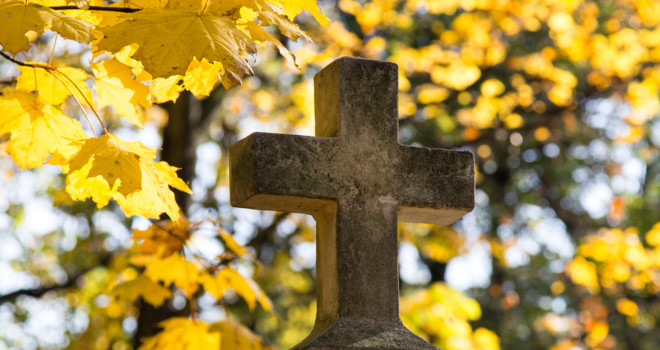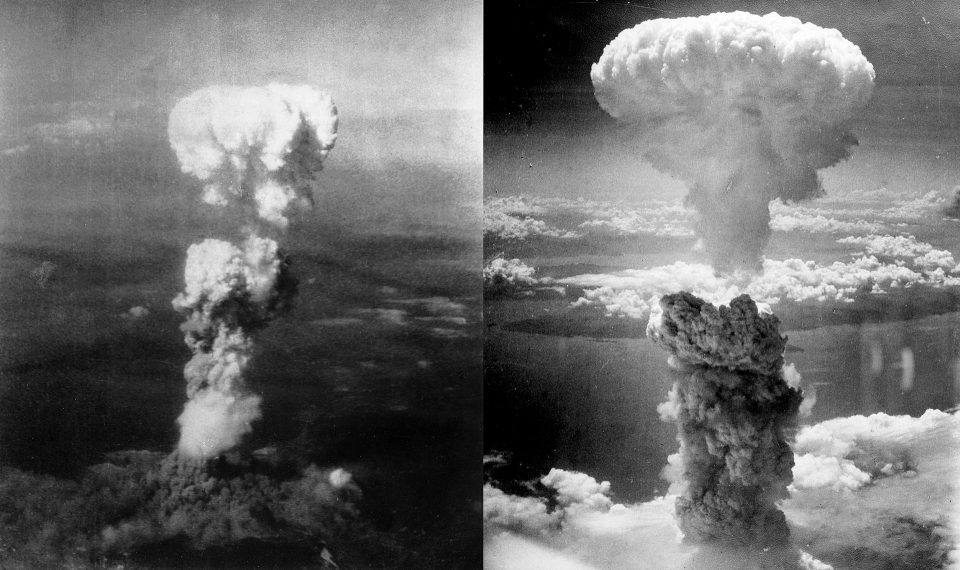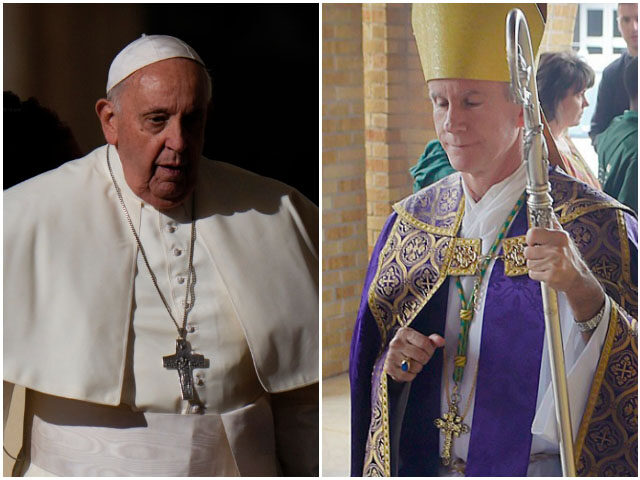EWTN Panel: Francis is Damaging Himself and Church by Not Answering Viganò’s Allegations
November 2, 2018Msgr. Charles Pope: Praying for Those Who Have Died Is a Work of Mercy
November 2, 2018
By Fr. Edward Looney, Catholic Exchange, November 2, 2018
Toward the end of the summer, as I was catching up on some of the television shows I like to follow, a few of them had a recurring and touching scene: one of the characters visiting a cemetery and having a heartfelt sharing with their deceased loved one(s). Penelope Garcia from Criminal Minds, after testifying for the release of the drunk driver who killed her parents, she visited their grave, tears streaming down her face, and apologized at their graveside to them for being the cause of why they were on the road that fateful night. Danny Reagan on Blue Bloods, visited the grave his wife and shared with her how difficult he finds life and handling their two sons.
Seeing these two expressions of faith on TV shows I watch reminded me of my many cemetery visits to the grave of my mother and grandmother and sharing how much I miss them and telling them that I hope they are proud of me.
I recommend visiting the graves of our loved ones often to those who experienced the loss of a parent, sibling, child, or friend. Doing so is quite biblical. Jesus visited the tomb of Lazarus, only to call him out and raise him from the dead. On the morning of the Resurrection, Mary Magdalene was on her way to the tomb of Jesus to pay her respects, when she discovered the empty tomb. As we visit the graves of our loved ones, we do so in anticipation of that day when God will call forth the dead from their graves into the fullness of resurrected life.
During the first 8 days of November, the Church strongly encourages and even incentivizes visits to cemeteries. Visits to cemeteries from November 1 to 8 are indulgenced according to the Enchiridion of Indulgences:
“Visit to a Cemetery. Only applicable to the souls in Purgatory when one devoutly visits and prays for the departed. A PLENARY INDULGENCE is bestowed for this work each day between November 1 and November 8.”
If you plan to visit a cemetery in November, or really anytime of the year, what should you do? How should you pray? Here are few helpful suggestions.
1. Have a Conversation
Like those characters who visited their family member’s graves and talked with them, we can do likewise. Something you want to celebrate? An accomplishment? Share it with them. Are you struggling with their death or encountering other difficult situations? Share it with them. Ask them to pray for you.
Whether they have entered the kingdom of Heaven or are still undergoing purification in Purgatory, our loved ones can intercede for us from their place in the eschaton. While you can talk to your loved one(s) anywhere, there is a certain closeness one might experience by doing so at their grave. Having that conversation might bring you the peace of mind and soul you are looking for.
2. Pray and Walk
One of the ways I like to pray in the cemetery is reciting the rosary and walking up and down the rows, looking at gravesites, the religious statuary, and other expressions of love people leave behind. When I walk around the cemetery in my hometown, I am reminded of all the local people who played an important role in my life, be it a school teacher, a CCD teacher, parishioner, or neighbor. I remember the different stories they told or experiences we had together. Also, when I walk around the cemetery, I will put statues upright that have fallen down, or pick up branches, in an effort to respect this home of the dead.
3. Pray the Divine Mercy Chaplet
Jesus told St. Faustina that the Divine Mercy Chaplet was an efficacious prayer for the dying: “Write that when they say this chaplet in the presence of the dying, I will stand between My Father and the dying person, not as the just Judge but as the merciful Savior” (Diary, 1541). During the Divine Mercy Novena, one day is dedicated to praying for the souls in Purgatory,
“Today bring to Me THE SOULS WHO ARE DETAINED IN PURGATORY, and immerse them in the abyss of My mercy. Let the torrents of My Blood cool down their scorching flames. All these souls are greatly loved by Me. They are making retribution to My justice. It is in your power to bring them relief. Draw all the indulgences from the treasury of My Church and offer them on their behalf. Oh, if you only knew the torments they suffer, you would continually offer for them the alms of the spirit and pay off their debt to My justice” (Diary, 1226).
St. Faustina received visits from the Souls who asked her to pray for them, and throughout the day she offered short prayers of petition for the faithful departed. In imitation of Jesus’ Apostle of Divine Mercy, we can pray the Divine Mercy Chaplet for the souls in Purgatory, offering it as a prayer of atonement for their sins, our sins, and those of the whole world.
4. Pray the Office for the Dead or Psalm 130
Priests, deacons, consecrated religious, and an increasing number of the lay faithful pray what is the called the Liturgy of the Hours. It is a collection of psalms and canticles from the Old and New Testament. The Liturgy of the Hours follows a four week psalter, and there are different prayers for each morning, daytime, and evening.
In addition to the various saint feast days and the Common of the Saints, there is a special set of prayers called “The Office for the Dead.” If you don’t have the four volumes of the Liturgy of the Hours, modern technology makes it easy to find the Office for the Dead. Just download the iBreviary app and look for it in the section labeled “Prayers.” If you don’t have time to pray the full Office for the Dead during your visit, pray Psalm 130, called the De Profundis, and a common Psalm used to pray for the dead.
Out of the depths I cry to You, O Lord; Lord, hear my voice. Let Your ears be attentive to my voice in supplication. If You, O Lord, mark iniquities, Lord, who can stand? But with You is forgiveness, that You may be revered. I trust in the Lord; my soul trusts in His word. My soul waits for the Lord more than sentinels wait for the dawn. More than sentinels wait for the dawn, let Israel wait for the Lord, for with the Lord is kindness and with Him is plenteous redemption, and He will redeem Israel from all their iniquities.
5. The St. Gertrude Prayer
St. Gertrude, a 13th century nun and mystic, received visits from Jesus. He allegedly taught her a prayer and told her that when prayed it would release 1,000 souls in Purgatory. It’s a short, beautiful, and powerful prayer. Eternal Father, I offer You the most precious blood of thy Divine Son, Jesus, in union with the Masses said throughout the world today, for all the Holy Souls in Purgatory, for sinners everywhere, for sinners in the universal Church, for those in my own home, and in my family. Amen.
6. The Litany of the Holy Souls
There are various litanies for the Holy Souls, available online. Print one out or save it on your phone so you can pray it during your visit. Here are a few:
7. Eternal Rest
The most common prayer for the faithful departed is the Eternal Rest prayer. It is my practice, and I highly recommend to all people, that during every visit to the cemetery to conclude your time with it. Eternal rest grant unto them, O Lord. And let the perpetual light shine upon them. May they rest in peace. And may their souls and the souls of all the faithful departed, through the mercy of God, rest in peace. Amen.
Other Resources about Purgatory and Praying for the Dead
© Copyright 2018 Catholic Exchange. All rights reserved.







